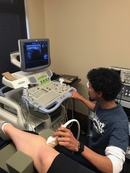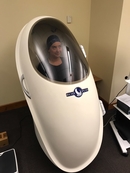Welcome! Listed below you can learn more about our equipment and protocol found in the NCCL Lab. We hope these descriptions help show you more about what we do in our lab day-to-day.
VO2 Max Test: This is a maximal effort test where we will increase intensities through a number of stages until you reach your max exertion. You will be performing this test on a cycle ergometer, and will also be hooked up to a mouthpiece that allows us to measure oxygen uptake, carbon dioxide output, and a number of other things. Some discomforts during this test might include shortness of breath at the end of the test, and discomfort due to the mouthpiece.
 Ultrasound: In our lab we use ultrasound technology in order to locate the nerves we are trying to study. Possible discomforts with ultrasound might include a sensation of cold due to the gel we must apply prior to use of the probe.
Ultrasound: In our lab we use ultrasound technology in order to locate the nerves we are trying to study. Possible discomforts with ultrasound might include a sensation of cold due to the gel we must apply prior to use of the probe.
Microneurography: We can directly measure muscle sympathetic nerve activity (MSNA) using the process of microneurography - where a small needle is inserted into the peroneal nerve on the side of the lower leg. Some discomforts with this measurement might include insertion of the needle, possible slight leg cramping, and leg restlessness due to sitting still for a longer period of time.
Tilt Test: During testing we have our participants strapped safely onto a tilt bed, which allows us to change the angle at which you are laying. Resultant discomforts might include dizziness from the change of angle.
Cold Pressor Test: This test protocol requires the participant to submerge their hand into a bucket of ice-water for a short period of time. Discomforts from this are often tingling in the hand, numbness, and cold extremities. As soon as the test in completed we wrap their hand in a warm towel in order to restore heat.
Handgrip Test: The handgrip test is where the participant will hold a hand-held device and continuously squeeze and release to the beat of a metronome at a percentage of their max. Discomforts that might arise include forearm muscle burning, or hand cramping.

Body Composition Testing: The egg-shaped Bod Pod (see picture) measures the body's composition of fat and muscles using air movement. This is an extremely accurate measure of body fat % . Discomforts associated with this measurement include a potential feeling of claustrophobia in some subjects.
Assessing Arterial Stiffness: We can determine arterial stiffness by measuring the velocity of the blood as it travels through the body. A small instrument called a tonometer is placed on your skin at the base of the carotid artery, which measures the noises the blood makes. Blood pressure will also be measured on the arm and the leg. Slight discomfort can occur with the tonometer as your carotid is close to your windpipe, as well as potential discomfort as a result of pressure from arm and leg cuffs.
 Assessing Blood Pressure (Arm and Finger Cuff): We use a standard arm cuff in order to obtain resting blood pressures prior to testing. We also have technology that allows us to use smaller finger cuffs that are connected to a machine where we can obtain simultaneous blood pressures during testing. Discomforts associated with the arm cuff might be tightness around the upper arm due to the cuff inflating. Discomforts from the finger cuffs might result in cold fingers due to a decrease in circulation from the inflating cuff. We however can change the finger the cuff is on during testing to prevent this.
Assessing Blood Pressure (Arm and Finger Cuff): We use a standard arm cuff in order to obtain resting blood pressures prior to testing. We also have technology that allows us to use smaller finger cuffs that are connected to a machine where we can obtain simultaneous blood pressures during testing. Discomforts associated with the arm cuff might be tightness around the upper arm due to the cuff inflating. Discomforts from the finger cuffs might result in cold fingers due to a decrease in circulation from the inflating cuff. We however can change the finger the cuff is on during testing to prevent this.
Electrode Placement: Electrode placement is used in our lab in order to acquire an EKG reading of electrical heart activity. We perform a three lead placement meaning electrodes will be placed near the left and right clavicles and one more below the umbilical and to the right. Some discomforts from electrodes might occur when removing them; they sometimes can leave a sticky residue.